
Rutidosis leptorrhynchoides, commonly known as button wrinklewort, is a flowering plant in the family Asteraceae. It is an upright, tufted, perennial herb with bright green leaves and yellow button-shaped flowers.
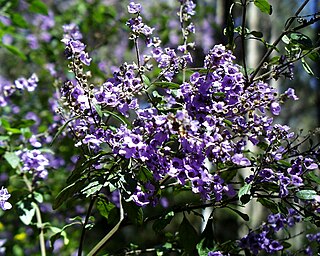
Prostanthera melissifolia, commonly known as balm mint bush, is a species of flowering plant in the family Lamiaceae and is endemic to south-eastern Australia. It is an erect shrub with hairy branches, egg-shaped leaves with fine teeth on the edges and mauve to purple or pink flowers on the ends of branchlets.
Eremophila elderi, commonly known as aromatic emu bush, is a flowering plant in the figwort family, Scrophulariaceae. It is endemic to central Australia where it grows near the border between Western Australia, South Australia and the Northern Territory. It is an erect, aromatic shrub with sticky leaves and branches and usually pale coloured to white flowers. Its specific epithet (elderi) honours an early Australian businessman, Thomas Elder.

Caladenia cairnsiana, commonly known as the zebra orchid, is a species of orchid endemic to the south-west of Western Australia. It is a common and widespread orchid distinguished by its red-striped labellum, and petals and lateral which are pressed against the ovary.
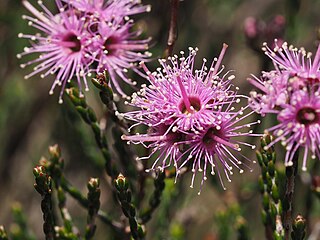
Kunzea opposita is a plant in the myrtle family, Myrtaceae and is endemic to eastern Australia. It is a spindly shrub which has small leaves arranged in opposite pairs, and pink flowers with five petals and many stamens, the stamens much longer than the petals. It usually grows in woodland or on exposed cliffs.

Dendrobium taylorii, commonly known as the smooth burr orchid, is an epiphytic or lithophytic orchid in the family Orchidaceae and is endemic to tropical North Queensland, Australia. It has a single leathery, dark green leaf on a cylindrical stem and one or two small white flowers. Unlike other burr orchids, this species is insect-pollinated. It grows in rainforest, mangroves and sheltered forests.
Liparis angustilabris, commonly known as the twisted sphinx orchid, is a plant in the orchid family and is endemic to northern Queensland. It is an epiphytic or lithophytic orchid with tapered pseudobulbs, each with a single linear leaf and up to thirty five pale green to yellowish flowers that have twisted sepals and petals. This orchid grows on trees and rocks in tropical North Queensland.

Olearia magniflora, commonly known as splendid daisy-bush, is a small shrub with clusters of deep mauve to purple flowers.

Brachyscome ascendens, the border ranges daisy, is a species of flowering plant in the family Asteraceae and is endemic to Australia. It has mostly mauve daisy-like flowers and a yellow centre.

Brachyscome graminea, commonly known as grass daisy, is a perennial herb in the family Asteraceae and is endemic to Australia. It has mostly mauve-pink or purple daisy-like flowers and a yellow centre.

Brachyscome decipiens, commonly known as field daisy, is a perennial herb in the family Asteraceae and is endemic to Australia. It is a small herb with white or pale blue flowers.

Bossiaea decumbens is a spreading, prostrate shrub in the pea family (Fabaceae), and is endemic to Victoria. It has alternate, variable shaped leaves and yellow pea flowers with red splotches from spring to late summer.

Rhadinothamnus euphemiae, is a slender, small, upright shrub with needle-shaped branchlets thickly covered with silvery scales and tubular greenish-purple tubular flowers throughout the year. It is endemic to the south coast of Western Australia.

Brachyscome nivalis, commonly known as snow daisy, is a perennial herb in the family Asteraceae and is endemic to Australia. It has mostly white daisy-like flowers, yellow centres and deeply lobed leaves.

Goodenia armitiana, commonly known as narrow-leaved goodenia or fine goodenia, is a species of flowering plant in the family Goodeniaceae and is endemic to northern Australia. It is an erect herb with sticky or vanished cylindrical leaves, racemes of yellow flowers with leaf-like bracts at the base, and more or less spherical fruit.
Elaeocarpus ruminatus, commonly known as brown quandong, caloon or grey quandong, is a species of flowering plant in the family Elaeocarpaceae and is endemic to Queensland. It is a tree with buttress roots at the base of the trunk, mostly more or less elliptic leaves, cream-coloured flowers with five petals that sometimes have a divided tip, and more or less spherical fruit.
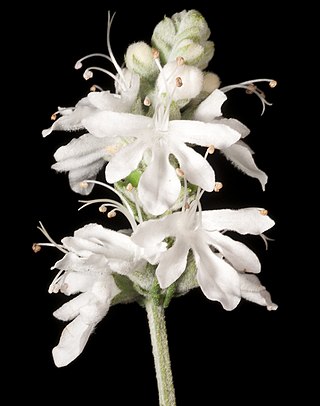
Teucrium eremaeum is a species of flowering plant in the family Lamiaceae and is endemic to the south-west of Western Australia. It is a perennial herb or shrub with small, linear to lance-shaped leaves and white or cream-coloured flowers.
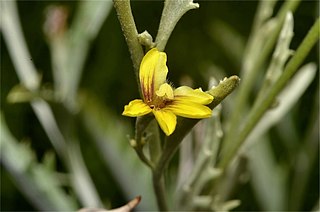
Goodenia mueckeana is a species of flowering plant in the family Goodeniaceae and is endemic to central Australia. It is an ascending, perennial herb with toothed, linear to egg-shaped leaves and racemes or thyrses of yellow flowers.
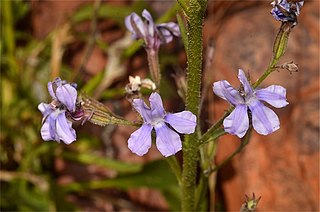
Goodenia ramelii is a species of flowering plant in the family Goodeniaceae and is endemic to central Australia. It is a perennial herb with toothed, elliptic leaves in a rosette at the base of the plant, and racemes of blue flowers.

Brachyscome spathulata, commonly known as spoon-leaved daisy, is a flowering plant in the family Asteraceae. It has dark green leaves, mauve daisy-like flowers and grows in New South Wales, Tasmania, Victoria and the Australian Capital Territory.

















